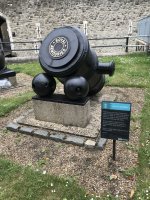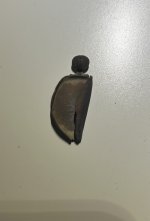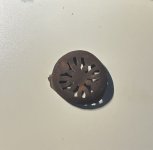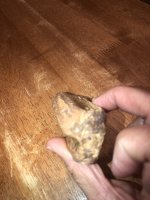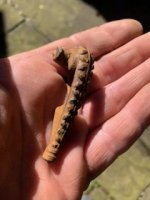You are using an out of date browser. It may not display this or other websites correctly.
You should upgrade or use an alternative browser.
You should upgrade or use an alternative browser.
How to finish cannonball found last week. Gemplers?
- Thread starter Tigerdude
- Start date
- Dec 30, 2012
- 7,429
- 13,992
- 🏆 Honorable Mentions:
- 2
- Detector(s) used
- Presently using Deus 2's & have Minelabs, Nokta's Tesoro's DEus's Have them all . Have WAY to many need to get rid of some
- Primary Interest:
- All Treasure Hunting
It keeps the Air off of them Be sure to spray the inside also
traveller777
Gold Member
- Aug 20, 2017
- 5,435
- 17,432
- Detector(s) used
- Minelab CTX 3030 & Explorer
- Primary Interest:
- All Treasure Hunting
There are two reasons to use hot wax. In the hot wax treatment you bring the wax up above the boiling temperature of water. This will purge any water from crevices, cracks, or entranced in metal or in any build up you could not remove. All my relics I have watched some water boil out. Bet a bunch moisture inside a cannonball. The other reason is the coating for protection.
But again, many different ways to skin a cat. I have experienced great success my skinning way. I wish you folks the best in your methods. I am sure they work well for you.
Any way, again all the best. Done with this thread. Have fun.
But again, many different ways to skin a cat. I have experienced great success my skinning way. I wish you folks the best in your methods. I am sure they work well for you.
Any way, again all the best. Done with this thread. Have fun.
crashbandicoot
Gold Member
Let me throw some cents in here,two or three or so..The hot wax route is a good one,I,ve waxed thousands of traps and trapline implements used in the most demanding conditions,it works. One thing,and a must for wax treatments is that the item must remain in the wax until no more bubbles come off the item and it reaches the temp of the wax,it,s not a dip and yank operation.The hot wax boils any moisture and it leaves the item as vapor,that,s the bubbles you see.The wax must be at a temperature above 212 degrees. When this is done,there,s no moisture left in the item to cause future rust and the wax coating is very thin,almost undetectable,in the pores of the metal so to speak. Seek out information on this,traveler has posted a very good video. Watch it carefully. A video or two on waxing traps and trapline equipment will no doubt help too. One thing about varnish and other applied clear coatings is you are likely to encapsulate moisture in the coated item and it will rust away merrily under the coating.One day flaking off and exposing a rusted surface,unless very careful preparation of removing all moisture before coating is attended to.Just something for you to think of.
traveller777
Gold Member
- Aug 20, 2017
- 5,435
- 17,432
- Detector(s) used
- Minelab CTX 3030 & Explorer
- Primary Interest:
- All Treasure Hunting
Amen. Nice overview, crash. And so true.Let me throw some cents in here,two or three or so..The hot wax route is a good one,I,ve waxed thousands of traps and trapline implements used in the most demanding conditions,it works. One thing,and a must for wax treatments is that the item must remain in the wax until no more bubbles come off the item and it reaches the temp of the wax,it,s not a dip and yank operation.The hot wax boils any moisture and it leaves the item as vapor,that,s the bubbles you see.The wax must be at a temperature above 212 degrees. When this is done,there,s no moisture left in the item to cause future rust and the wax coating is very thin,almost undetectable,in the pores of the metal so to speak. Seek out information on this,traveler has posted a very good video. Watch it carefully. A video or two on waxing traps and trapline equipment will no doubt help too. One thing about varnish and other applied clear coatings is you are likely to encapsulate moisture in the coated item and it will rust away merrily under the coating.One day flaking off and exposing a rusted surface,unless very careful preparation of removing all moisture before coating is attended to.Just something for you to think of.
FreeBirdTim
Silver Member
- Sep 24, 2013
- 3,781
- 6,765
- 🥇 Banner finds
- 1
- Detector(s) used
- Garrett AT Pro
- Primary Interest:
- All Treasure Hunting
I use rust converter on my iron relics. Much safer and easier to do. Sometimes a small amount of rust will eventually come back, but all I do is brush on another coat of rust converter to stop it.
ThatDixieGuy
Newbie
- May 12, 2016
- 4
- 7
- Primary Interest:
- All Treasure Hunting
For safety, never attempt anything other than surface cleaning on a shell that has not been unloaded
A few things I can add here:
--Before doing anything, I would boil this shell in hot water - repeatedly until the water finishes clean. This is done after electrolysis & some folks say use distilled water. Your giant gumbo pot & burner outdoors will work for this. This will force out most of the oxides & impurities in prep for finishing it. This boiling is especially important for anything that may have been exposed to salt water. While I can see this shell is hollow & likely safe to heat, be careful with this approach with other shells or relics as they might contain air pockets or impurities that will rapidly expand when heated, explosively shooting hot water/wax everywhere. I've seen it happen to what I was certain was a solid ball & it's ugly.....deadly if you're standing nearby. Confederate & mid 19th century iron-casting was far from perfect - you'll get surprises any way you work it. After the water treatment, you'll need to dry the artifact & 24 - 48 hours in the oven at 200f should do it. With today's weather you may be able to just sit it in the sun for a couple of days.
--If you decide to go with the wax treatment, look for microcrystalline wax (museum wax) as opposed to paraffin. Jacquard microcrystalline is best. Watch the heat closely & be aware of flashpoint. The video above explains the process & there are others on the net also. Be careful.
--My preference - Gempler's will work fine after a thorough cleaning, and I've always like the end finish & color. It's also not the messy project or danger that wax is. Be sure to slosh it all around inside the cavity as well. I'm not a fan of varnish or related sealants as this method will lock in any moisture still present & now your relic will rot from the inside out. I have some of these & they're heartbreaking as a collector.
More info here:
https://www.patriotrelics.com/how-to-clean-iron-relics
http://www.advanceddivermagazine.com/articles/artifactpreservation/artifactpreservation.html
A few things I can add here:
--Before doing anything, I would boil this shell in hot water - repeatedly until the water finishes clean. This is done after electrolysis & some folks say use distilled water. Your giant gumbo pot & burner outdoors will work for this. This will force out most of the oxides & impurities in prep for finishing it. This boiling is especially important for anything that may have been exposed to salt water. While I can see this shell is hollow & likely safe to heat, be careful with this approach with other shells or relics as they might contain air pockets or impurities that will rapidly expand when heated, explosively shooting hot water/wax everywhere. I've seen it happen to what I was certain was a solid ball & it's ugly.....deadly if you're standing nearby. Confederate & mid 19th century iron-casting was far from perfect - you'll get surprises any way you work it. After the water treatment, you'll need to dry the artifact & 24 - 48 hours in the oven at 200f should do it. With today's weather you may be able to just sit it in the sun for a couple of days.
--If you decide to go with the wax treatment, look for microcrystalline wax (museum wax) as opposed to paraffin. Jacquard microcrystalline is best. Watch the heat closely & be aware of flashpoint. The video above explains the process & there are others on the net also. Be careful.
--My preference - Gempler's will work fine after a thorough cleaning, and I've always like the end finish & color. It's also not the messy project or danger that wax is. Be sure to slosh it all around inside the cavity as well. I'm not a fan of varnish or related sealants as this method will lock in any moisture still present & now your relic will rot from the inside out. I have some of these & they're heartbreaking as a collector.
More info here:
https://www.patriotrelics.com/how-to-clean-iron-relics
http://www.advanceddivermagazine.com/articles/artifactpreservation/artifactpreservation.html
ARC
Gold Member
- Aug 19, 2014
- 37,231
- 131,466
- Detector(s) used
- JW 8X-ML X2-VP 585
- Primary Interest:
- All Treasure Hunting
***ARC says in a Chong from Cheech and Chong voice***Have you ever done hot wax?
"Hey man like far out... you got wax man" ?
:P
davidbird42
Tenderfoot
- Dec 13, 2012
- 8
- 9
- Primary Interest:
- All Treasure Hunting
Yup, oxygen is the culprit for the rust and I use a light spray of matte clear acrylic spray paint. Seals it nicely but keeps it looking natural. Also, when I did my degree in archaeology we used Renaissance Wax is a brand of microcrystalline wax polish used in antique restoration and museum conservation around the world. Commonly used to polish and conserve metal objects, it is also used on gemstones and such organic materials as wood, ivory, and tortoiseshell.View attachment 2035049
It will rust up if I stop here. Thinking about gemplers rust converter. What do y’all think?
Andysfinds
Jr. Member
- May 22, 2022
- 22
- 60
- Detector(s) used
-
Cscope 3mxi pro (inland)
Cscope pi (beach)
- Primary Interest:
- All Treasure Hunting
I came across a 16th century cannon ball rusted as f... and cracked just about ready to fall to bits. Super glue down the cracks, quick sanding down then here is the secret, rubberized blackboard paint. Last forever now, sold on.View attachment 2035049
It will rust up if I stop here. Thinking about gemplers rust converter. What do y’all think?
Top Member Reactions
-
 2605
2605 -
 1160
1160 -
 1047
1047 -
 892
892 -
 871
871 -
 842
842 -
 788
788 -
 675
675 -
 661
661 -
 641
641 -
 492
492 -
 470
470 -
 467
467 -
 462
462 -
 459
459 -
 432
432 -
 415
415 -
 410
410 -
O
401
-
 389
389
Users who are viewing this thread
Total: 2 (members: 0, guests: 2)
Latest Discussions
-
-
-
-
-
Antique Sword Garage Sale Find, Makers Mark Identification? US or Foreign?
- Latest: Bucket Lister



